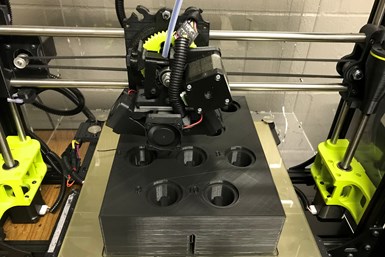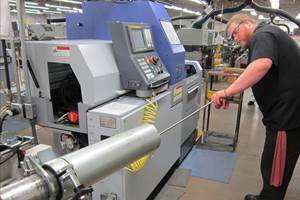
Inexpensive polymer 3D printers such as this unit from LulzBot can be used to create a range of helpful items like toolholder trays for use in a machine shop. (Photo Credit: Superior Metal Products)
Publications such as Production Machining develop and follow annual editorial calendars. We create these to ensure we cover a range of relevant ideas, technology, equipment and processes over the year to help shops like yours become more profitable and efficient operations. One calendar topic this month is 3D printing. The article explains how a division of Eaton Corp. uses metal additive manufacturing both for production parts and toolroom use. In addition, our Last Word column was penned by Stephanie Hendrixson, executive editor of our sister brand Additive Manufacturing, who describes various ways to use polymer 3D printers on the shop floor.
The latter calls to mind one common question I ask during my visits to shops. I want to know if the shop is using a 3D printer, had plans to buy one or was currently sitting on the sidelines waiting to see where 3D printing finds its niche. Of those that do have one, it’s typically a polymer 3D printer instead of one that prints metal. Those are relatively inexpensive, and the (somewhat jokingly) comment I frequently receive as to why the shop purchased one is “we wanted to play with it.”
I also recall spending a week visiting a number of shops in Minnesota a few years ago to create articles on various topics. I found that nearly every one of them had a 3D printer(s). Some were using theirs more than others, but I remember seeing a good amount of nifty plastic printed items, including CMM inspection fixtures, robot grippers, and parts collection chutes and containers. One shop happened to hire a couple engineers fresh out of college soon after purchasing its first 3D printer. They really took to it, demonstrating how printing plastic devices such as the ones mentioned above would be simpler, faster and cheaper than the traditional route of producing them from metal in the tool room.
Similarly, I recently visited another shop that purchased a relatively inexpensive 3D printer with which to experiment. It had no specific goal for how it might use the printer. However, that purchase enticed two of its employees to make their own 3D printers to play with at home. Experimenting with their homemade devices sparked the employees’ creativity and printing know-how. It eventually led them to use the shop’s 3D printer to make helpful items throughout the facility. Many of these items supported the shop’s 5S workplace organization efforts, such as hangers for brooms, trays for hand gages and so on.
So, given the relatively low cost of some polymer 3D printers, should you consider buying one for use in your shop (and making sure employees have ample time to use it) and another to loan or even give to a bright, young employee to noodle with at home? Or, one a few employees could share throughout the year?
Doing this demonstrates that you recognize your employees’ creativity and want to feed it.
Giving employees the freedom to design and print anything that is personally interesting — not specifically something for your shop — enables them to figure out how to optimize the process for other similar prints that might be useful for your operation. They’ll also learn how to use CAD software and create STL files, determine how to best apply support structures for complex prints, consider how the function of a part dictates the proper orientation during printing and gain experience troubleshooting printing problems. Doing this also demonstrates that you recognize and appreciate your employees’ creativity and want to feed it. They will then naturally be on the lookout for creative ways to use your printer to make useful items from which your shop can benefit.
Perhaps more importantly, this might get them to think more consistently about continuous improvement opportunities for your shop in general and feel empowered to make such suggestions. This could then become contagious throughout your entire staff. Email me and let me know what you think of this idea.
Related Content
Manufacturing Skills Training: Virginia Martinez and Laiken Carrillo
Roles of Women in Manufacturing Series: A precision machining career starts with skills. Virginia and Laiken share their journey and how they help prepare the next generation.
Read More6 Tips for Training on a Swiss-Type Lathe
There are nuances to training a person to effectively operate a Swiss-type lathe. A shop I visited a while back offers some suggestions.
Read MoreRecognizing Signs of a Degrading Workplace Culture
Is your machine shop missing key “culture elements?” Here are ways to identify if your organization is heading in the right or wrong direction in terms of establishing a healthy company culture.
Read MoreJob Candidate Questions and What They Tell Us
Individuals who ask thoughtful, original questions in the interview set themselves apart.
Read MoreRead Next
Helpful, Free CAD Model for Those Who Machine DOM Tubing
This machine shop 3D prints a plastic plug that it inserts into the end of tubing to prevent chips and coolant from entering the lathe's bar feeder. It offers a free CAD model of it for other shops machining that material.
Read MoreVideo Tech Brief: Vacuum-Assist Collection of Small, Machined Parts
Marubeni Citizen-Cincom offers an optional vacuum collection system for very small parts machined on its Swiss-type CNC lathes to avoid losing or damaging parts. Main system components are 3D-printed made at its U.S. headquarters.
Read More3D Printing Creates a Window of Automation Opportunity
For this Omaha shop, periodic part inspection required an automated turning cell to pause production. Printing a plastic parts collection chute for delivery outside the cell solved this problem, and it turns out the shop has found 3D printing to be valuable in many other ways.
Read More























